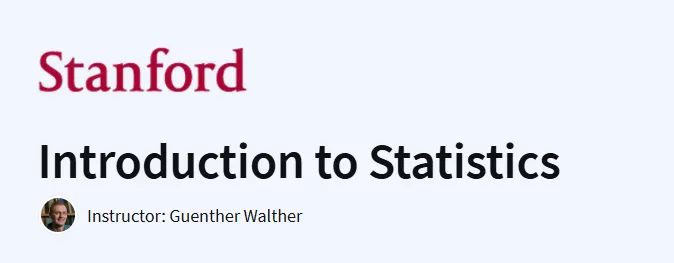What you will learn in Introduction to Statistics Course
Learn core concepts in descriptive and inferential statistics
Visualize and summarize data using graphs and numerical techniques
Understand probability, distributions, and sampling methods
Conduct hypothesis testing and interpret results
- Apply basic regression techniques and analyze relationships
- Learn resampling methods including bootstrapping
- Gain experience in real-world statistical problem solving
Program Overview
Descriptive Statistics & Data Visualization
⏱️ 1 week
- Explore data types and graphical representations
- Calculate central tendency (mean, median) and spread (variance, SD)
- Learn to summarize large datasets meaningfully
Producing and Sampling Data
⏱️ 1 week
- Learn how to design surveys and experiments
- Understand sampling methods and potential biases
- Distinguish observational studies from experimental design
Probability Concepts
⏱️1 week
- Learn probability rules, conditional probability, and independence
- Work with discrete and continuous distributions
- Understand how probability supports inference
Sampling Distributions & Central Limit Theorem
⏱️ 1 week
- Learn how sample statistics vary
- Apply the Central Limit Theorem
- Understand the basis of inferential statistics
Regression Analysis
⏱️ 1 week
- Introduce simple linear regression
- Interpret regression output
- Use correlation to measure variable relationships
Significance Tests
⏱️ 1 week
- Perform t-tests and chi-square tests
- Understand p-values and confidence intervals
- Learn about errors in hypothesis testing
Resampling Techniques
⏱️ 1 week
- Explore bootstrapping and permutation testing
- Use simulations to draw conclusions
Multiple Comparisons
⏱️ 1 week
- Learn methods for dealing with multiple hypotheses
- Control false discovery rates
Get certificate
Job Outlook
- Strong demand across industries for statistical knowledge
- Relevant for roles in data analysis, business intelligence, and research
- Serves as a stepping stone to more advanced fields like data science
- Employers value statistical reasoning for decision-making
- Complements tools like Python, R, and Excel in analytics jobs
- Builds foundational knowledge required for AI and ML pathways
- Applicable in fields like economics, medicine, marketing, and policy
Specification: Introduction to Statistics
|
FAQs
- Not at all—it’s beginner-friendly and doesn’t require advanced math skills like calculus or linear algebra.
- The course covers foundational topics like descriptive statistics, probability, regression, hypothesis testing, and resampling methods—all explained clearly for novices.
- You’ll learn concepts using intuitive explanations and practical examples, rather than heavy formulas.
- It’s structured to gradually build your statistical understanding, starting from data visualization and moving to inference.
- According to Course Platform, it’s “a high-quality, beginner-friendly stats course from Stanford that builds essential analytical skills without requiring advanced math.”
- It’s designed to be completed in 7 weeks, with roughly one module per week.
- Each module focuses on a core statistical concept: Descriptive Stats & Visualization, Sampling & Data, Probability, CLT & Sampling Distributions, Regression, Significance Testing, Resampling, and Multiple Comparisons.
- Your time commitment per week can vary—some platforms cite about 15 hours total, over 8 weeks.
- If you’re quick and motivated, you can finish faster—modules are unlocked and you learn at your own pace.
- Conversely, self-paced flexibility means you can slow down if needed, revisiting concepts until you’re confident.
- Descriptive Statistics & Visualization: Learn to graph data and compute mean, median, variance, standard deviation, and interpret datasets visually.
- Producing and Sampling Data: Explore how to design surveys/experiments, identify sampling methods, and recognize bias.
- Probability Concepts: Cover basic rules, conditional probability, discrete and continuous distributions, and how these support inference.
- Sampling Distributions & CLT: Discover how sample statistics vary, and gain foundational understanding of inferential statistics.
- Regression, Significance Tests, Resampling, & Multiple Comparisons: Learn simple linear regression, t-tests, chi-square, confidence intervals, bootstrapping, permutation testing, and how to handle multiple hypothesis testing.
- Yes—it gives you a strong foundation in statistical reasoning that’s essential for data analysis across industries.
- You’ll be able to visualize and interpret data, choose appropriate tests, and draw meaningful conclusions—all skills hiring teams appreciate.
- Topics like hypothesis testing, regression, and resampling methods are directly relevant in roles like data analyst, BI, research, and beyond.
- Though the course doesn’t focus on software tools, it prepares you conceptually; pairing it with Python, R, or Excel gives you practical power.
- Course Platform notes that employers value this kind of statistical reasoning for decision-making, making it a useful stepping stone into AI/ML or more advanced analytics.
Pros:
- Developed by Stanford—a reputable and trusted source.
- Beginner-friendly and self-paced; you can learn at your comfort level.
- Covers a comprehensive range of statistical topics, with real-world applications.
- Free to audit, with option to pay for a certificate.
- Gives a solid theoretical framework to support analytics careers or further studies.





